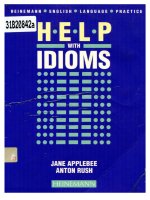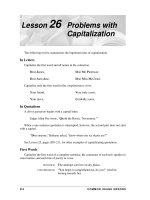Comma with conjunctions
Bạn đang xem bản rút gọn của tài liệu. Xem và tải ngay bản đầy đủ của tài liệu tại đây (8.17 KB, 1 trang )
Comma with conjunctions
Conjunctions
do not normally cause major grammatical errors. However, students sometimes incorrectly use two
conjunctions to connect two clauses. In English, we need just one conjunction to connect two clauses. If there are
four clauses in the sentence, we need just three conjunctions to connect them.
Another common problem is the confusion about the placement of comma. Sometimes we use a comma before a
conjunction. Sometimes we do not use a comma.
When
subordinate clauses
begin a sentence, we usually separate them from the rest of the sentence with a
comma. When the subordinate clause goes after the main clause, the comma can be left out.
While there are no simple rules regarding the placement of comma with conjunctions, the following guidelines
should help.
Comma before the final item in a list
We use commas to separate items in a series or list. The last two items in a list are usually connected by
and
. In
British English, it is quite unusual to use a comma with
and.
I visited France, Germany, Italy, Britain and Spain. (GB)
I visited France, Germany, Italy, Britain, and Spain. (US)
Notes
When there are just two items in a list, a comma is not necessary before
and.
I met John and Mary. (NOT I met John, and Mary.)
When there are more than two items, some people prefer to use a comma before and. Some people do not use a
comma. There is no right or wrong answer here. Pick a convention and then stick with it. That’s all.
The comma that goes before the conjunction is called the
Oxford Comma.
Interestingly, although it is
called
Oxford Comma
, it is mainly used by writers in the US.
I bought some milk, eggs, and butter. (List with Oxford Comma)
I bought some milk, eggs and butter. (List without Oxford Comma)
Be first to know when grammar rules change! Sign up to our newsletter here: englishgrammar.org (It's free)
Powered by TCPDF (www.tcpdf.org)









